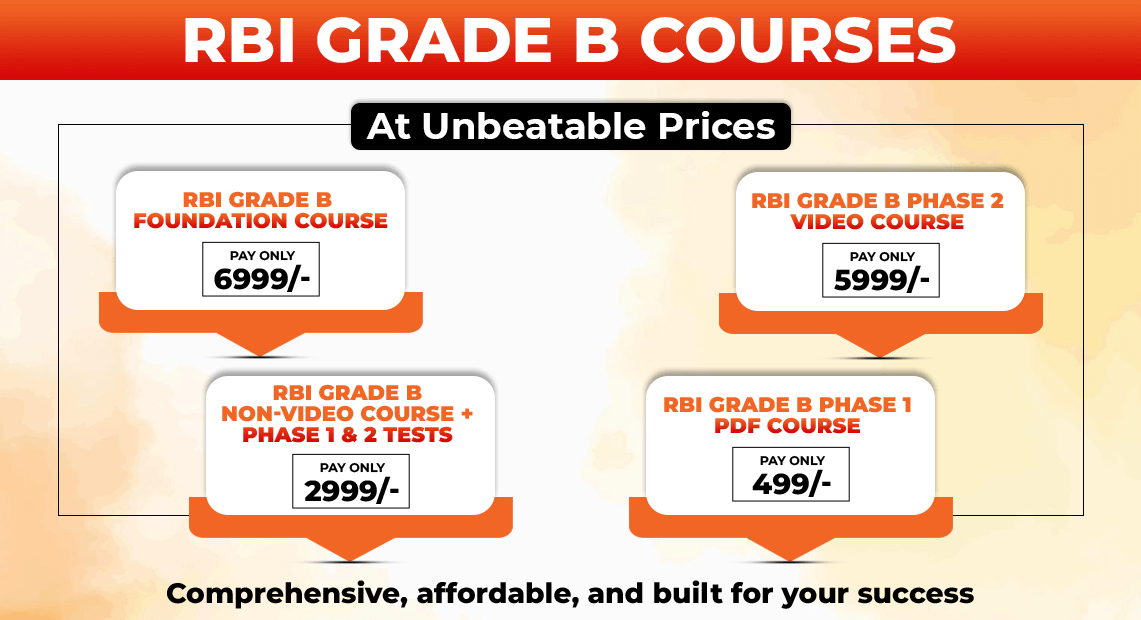If we take a look at previous exams, we’ll find that average questions usually comprise 2 to 4 of all the questions asked on the Quant section of the RBI Grade B Phase 1 exam. This comes to about 7 to 13% of the Quantitative Aptitude section. That makes this topic worth mastering. In this blog, you’ll get the most important formulas. You’ll learn smart tricks to solve average questions fast. You’ll also get simple examples with full steps. By the end, you’ll tackle average questions with ease and confidence.
ALSO READ: How to Score Maximum Marks in Cloze Test
What Is Average?
Average/or mean is the central value of a group of numbers.
Formula:
Average = (Sum of values) divided by (Number of values).
This idea pops up in many types of questions:
- Find a missing number.
- Work with group averages.
- Compare inside and outside values.
Before you move on, you must know the main formulas that are essential to solving such questions.
Main Formulas to Remember
Given below are the formulae that you must learn by heart and learn to apply them through regorous practice:
Simple Average
Sum = Average × Count.
If the average is 40 for 5 numbers, then, the total is 40 × 5 = 200.
Total using average
Total Sum = Average multiplied by Number of terms.
Weighted average
When values have different weights:
Average = (Sum of (value × weight)) divided by (Sum of weights).
Group average trick
If Group A has avg 30 for 10 items and Group B has avg 50 for 20 items:
Combined avg = (30×10 + 50×20) ÷ (10+20) = (300 + 1000) ÷ 30 = 43.33.
Missing value from average
If the average of 5 people is 20, and one has 30. Find the average of the other 4.
Sum = 5×20 = 100.
Remaining sum = 100 – 30 = 70.
New average = 70 ÷ 4 = 17.5.
ALSO READ: How to Score Maximum Marks in Cloze Test & Ratio & Proportion Concepts and Shortcuts for RBI Grade B Exam
5 Tricks to Score Fast
Here are some smart ways to solve average questions quickly in RBI Grade B Phase 1. Each trick has an example so you can see it in action.
1. Use formula in reverse to find total fast
Formula: Total = Average × Number of items.
Instead of adding all numbers, reverse the formula. Multiply the average by the number of items.
Example: Average score of 12 students = 45.
Total marks = 45 × 12 = 540. Done in 2 seconds.
2. For group averages, add weighted sums
When two or more groups are given, find the total marks of each group. Then add them. Divide by the total number of items.
Example: Class A has 20 students, avg = 60. Class B has 25 students, avg = 70.
Total A = 20 × 60 = 1200. Total B = 25 × 70 = 1750.
Combined total = 2950. Total students = 45.
Combined avg = 2950 ÷ 45 = 65.55.
3. Remove one value and recalculate
If you know the total and remove one number, just subtract it from the sum and divide again.
Example: Average of 5 matches = 50 runs. Total = 250.
One match score = 40. New total = 250 – 40 = 210.
New avg = 210 ÷ 4 = 52.5.
4. Compare two averages using ratio logic
Sometimes you don’t need full calculation. You can compare averages using ratios. This saves time.
Example: Average age of Group A = 20, Group B = 30. Number of people = 2:3.
Overall avg = (20×2 + 30×3) ÷ (2+3) = (40 + 90) ÷ 5 = 26.
Here, ratio method makes it easier to set up the weighted average.
5. Use approximation when values are easy, like multiples of 10
If numbers are close to round figures, round them up or down for faster calculation. Then adjust.
Example: Find average of 49, 51, 52, 48, 50.
Round all to 50. Sum = 50×5 = 250.
Check adjustments: +(-1) + (+1) + (+2) + (-2) + 0 = 0.
Total still = 250. Average = 250 ÷ 5 = 50.
These tricks are easy to learn. They save precious seconds in the exam. Practice them daily until they become automatic. Once you get used to spotting the right trick, average questions become your fastest source of marks.
Practice Examples
Example 1: Missing number
Five numbers have a total average of 24. Four numbers are 22, 27, 26, and 23. What is the fifth?
Sum = 5 × 24 = 120. Sum of four = 98. Missing = 22.
Example 2: Group average
Class A (10 students) avg = 70. Class B (15 students) avg = 80. What’s combined avg?
Total sum = 10×70 + 15×80 = 700 + 1200 = 1900. Students = 25. Avg = 1900 ÷ 25 = 76.
Example 3: Remove lowest score
Six scores average 60. Lowest score is 40. New average of remaining five?
Sum = 6×60 = 360. Remaining sum = 320. New avg = 320 ÷ 5 = 64.
Example 4: Compare with baseline
Average of 8 values = 50. Two values are 40 and 60. New average of remaining six?
Sum = 8×50 = 400. Remaining sum = 400 – (40 + 60) = 300. New avg = 300 ÷ 6 = 50.
How to Practice Well
Practice is as important as preparation. You can start slow, then write sums and formulas. Then, time yourself later. Use ≤1 minute per question. Mix missing value, group, and weighted problems. At the end, write the mistakes you committed in a note. Revise them daily.
Daily Mini Task:
Here’s the daily task for you:
- Solve at least 5 average questions.
- Include one group average.
- Include one missing value type.
- Learn one shortcut or trick.
- Note down mistakes and revise them before you sleep.
Do this 10 days in a row. You will see a big improvement.
ALSO READ: Word Swap Tricks for RBI Grade B Phase 1 Exam
Are you preparing for the RBI Grade B exam 2025? If so, it’s the ideal time to start and accelerate your exam preparation. The notification can be released anytime soon!
Start preparing with the course that best suits you below!

Final Takeaway
Average is a frequent and fussy topic in RBI Grade B Quant. Once you know the formulas and shortcuts, it’s quick to solve. With a little daily practice, you can confidently solve any average question in the exam. This topic’s clarity and practice can give you those easy, reliable marks.
FAQs
Usually 2–4 questions, around 7–13% of the Quant section.
Yes. Average × Count gives you the sum.
Two or more groups with different avgs, combined to find overall avg.
Yes. Use value × weight and divide by total weight.
Not here. You must be accurate, then fast.
- Sign Up on Practicemock for Updated Current Affairs, Topic Tests and Mini Mocks
- Sign Up Here to Download Free Study Material
Free Mock Tests for the Upcoming Exams
- IBPS PO Free Mock Test
- RBI Grade B Free Mock Test
- IBPS SO Free Mock Test
- NABARD Grade A Free Mock Test
- SSC CGL Free Mock Test
- IBPS Clerk Free Mock Test
- IBPS RRB PO Free Mock Test
- IBPS RRB Clerk Free Mock Test
- RRB NTPC Free Mock Test
- SSC MTS Free Mock Test
- SSC Strenographer Free Mock Test
- GATE Mechanical Free Mock Test
- GATE Civil Free Mock Test
- RRB ALP Free Mock Test
- SSC CPO Free Mock Test
- AFCAT Free Mock Test
- SEBI Grade A Free Mock Test
- IFSCA Grade A Free Mock Test
- RRB JE Free Mock Test
- Free Banking Live Test
- Free SSC Live Test



